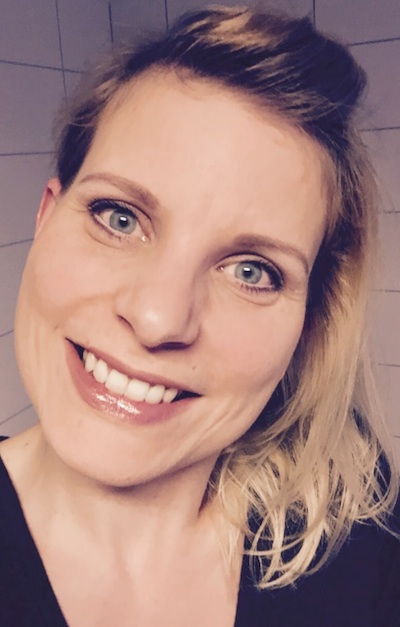Cambridge 7th to 9th September

Presenting Author:
Martina Stoica
<martina.stoica@uni-jena.de>
article posted 22 Apr 2015
Martina Stoica
Martina Stoica graduated with Diploma in Chemistry from the University of Jena in 2011 and
since January 2012 has been working on her PhD at the Otto-Schott-Institut of Materials
Research, which is part of the University of Jena, under the supervision of Prof. Dr. C. Rüssel.

Photo induced crystallization of CaF2 from a
Na2O/ K2O/ CaO/ Al2O3 / CaF2/ SiO2 glass
Martina Stoica*, Guilherme Nunes Braga Maurício de Macedo
and Christian Rüssel
Otto-Schott-Institut of Materials Research, University Jena,
Fraunhoferstraße 6, 07743 Jena, Germany
A photo-thermo-refractive glass (PTRG) is a silicate glass which is doped with Ce, Ag, Sb and Sn. It undergoes a permanent refractive index change after UV irradiation and subsequent two step heat treatment. Therefore, it can be specifically structured and offers great potential as volume Bragg grating. The classical PTR glass is based on the crystallization of NaF from an alkali alumosilicate glass. By contrast, we studied glasses in the system Na2O/ K2O/ CaO/ Al2O3 / CaF2/ SiO2 doped with Ag2O, CeO2, KBr, SnO2 and Sb2O3 which enable the crystallization of CaF2 and have a potential of much larger differences in the refractive indices of radiated and non-radiated parts of the glass.
 The homogenous, colorless and transparent glass samples we obtained were irradiated
with UV light. This led to the oxidation of Ce3+ to Ce4+ in the glass, where an electron
is released, trapped by Ag+ which is reduced to elemental AgO. Then the samples were
heat treated at 530 °C just above Tg for 1 h. This led to a slightly yellowish color, which
is due to the formation of silver clusters. This was proven by a typical plasmon resonance
peak at 425 nm in the UV-vis spectrum.
The homogenous, colorless and transparent glass samples we obtained were irradiated
with UV light. This led to the oxidation of Ce3+ to Ce4+ in the glass, where an electron
is released, trapped by Ag+ which is reduced to elemental AgO. Then the samples were
heat treated at 530 °C just above Tg for 1 h. This led to a slightly yellowish color, which
is due to the formation of silver clusters. This was proven by a typical plasmon resonance
peak at 425 nm in the UV-vis spectrum.
 A second heat treatment step at 560 °C led to the
nanocrystallization of cubic CaF2, as shown by X-Ray diffraction.
The crystallization results in a permanent refractive index change of n ≥ 10-3, tenfold
that in a conventional NaF PTR glasses. Samples which were annealed in a two-step
process without prior irradiation did not show crystallization. It was found that both
heat treatment steps are essential for the crystallization of CaF2.
With an increase in the irradiation time, the volume concentration of cubic
CaF2 increases, but the particle size was not affected.
Nanocrystals with diameters in the range from 50 to 400 nm were observed by
scanning electron microscopy.
A second heat treatment step at 560 °C led to the
nanocrystallization of cubic CaF2, as shown by X-Ray diffraction.
The crystallization results in a permanent refractive index change of n ≥ 10-3, tenfold
that in a conventional NaF PTR glasses. Samples which were annealed in a two-step
process without prior irradiation did not show crystallization. It was found that both
heat treatment steps are essential for the crystallization of CaF2.
With an increase in the irradiation time, the volume concentration of cubic
CaF2 increases, but the particle size was not affected.
Nanocrystals with diameters in the range from 50 to 400 nm were observed by
scanning electron microscopy.
 The effects of the irradiation time on the crystallization behaviour and the role of KBr
in the photo induced crystallization process were studied. The glass samples which
were melted without KBr, showed crystallization of cubic CaF2
after both heat treatment steps even without prior irradiation. Spontaneous crystallization
predominates. Consequently, KBr plays an important role in the photo-induced
crystallization process.
The effects of the irradiation time on the crystallization behaviour and the role of KBr
in the photo induced crystallization process were studied. The glass samples which
were melted without KBr, showed crystallization of cubic CaF2
after both heat treatment steps even without prior irradiation. Spontaneous crystallization
predominates. Consequently, KBr plays an important role in the photo-induced
crystallization process.

Reference:
M. Stoica, G. M. de Macedo, C. Rüssel, Opt. Mater. Express 4, 1574-1585 (2014)
